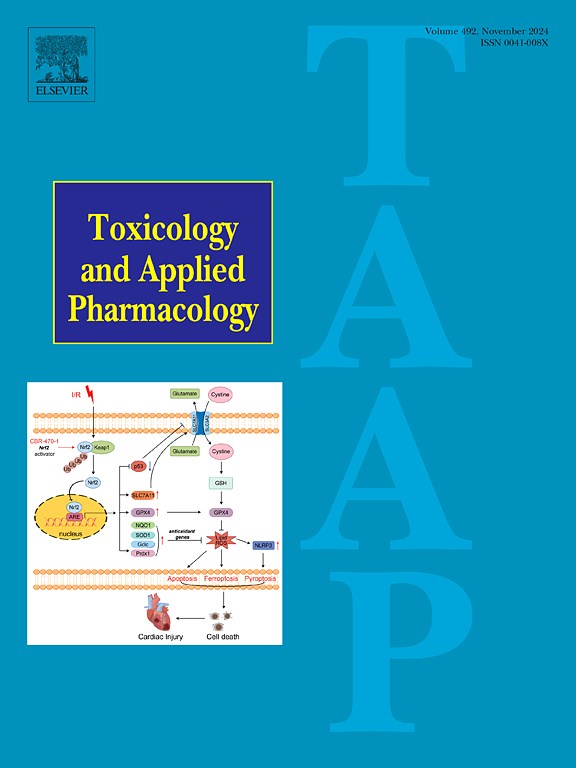两种甲状腺毒物:丙基硫尿嘧啶和孕烯醇酮16α‑碳腈的不同作用机制的毒性动力学见解。
IF 3.3
3区 医学
Q2 PHARMACOLOGY & PHARMACY
引用次数: 0
摘要
甲状腺激素(THs)对代谢调节和大脑发育至关重要。TH体内平衡的破坏,特别是在胎儿发育期间,可导致不可逆的神经发育障碍。甲状腺激素系统干扰化学物质(THSDCs)因其可能干扰甲状腺激素信号传导而日益受到人类健康的关注。本研究研究了两种THSDCs:抑制TH合成的丙基硫脲嘧啶(PTU)和促进TH肝脏代谢的孕烯醇酮-16α -碳腈(PCN)的毒性动力学特性。采用体外方法和体内模型,包括怀孕、胎儿和新生大鼠,我们旨在表征这些化合物的吸收、分布、代谢和排泄(ADME)特征。评估肝脏代谢、未结合分数、血浆浓度和PTU和PCN的组织分布。我们的研究表明,PCN经过快速的肝脏代谢,导致在成年和新生大鼠组织以及母乳中检测不到PCN水平。相反,PTU通过肠道屏障具有高通透性,被肝脏缓慢代谢,导致胎儿和新生儿的母乳、甲状腺和大脑中PTU浓度较高。这些结果引起了人们对PTU对新生儿大脑发育的潜在直接影响的关注。特别是,PTU可以与参与解毒过程的脑过氧化物酶相互作用的假设值得进一步研究。这些发现强调了THSDC暴露、改变TH合成和代谢以及随后对神经发育的影响之间的复杂关系。本文章由计算机程序翻译,如有差异,请以英文原文为准。
Toxicokinetic insights into distinct mechanisms of action of two thyroid toxicants: Propylthiouracil and pregnenolone 16α‑carbonitrile
Thyroid hormones (THs) are critical for metabolic regulation and brain development. Disruptions in TH homeostasis, especially during fetal development, can lead to irreversible neurodevelopmental impairments. Thyroid hormone system-disrupting chemicals (THSDCs), are of growing concern for human health due to their potential to interfere with TH signaling. This study investigates the toxicokinetic properties of two THSDCs: propylthiouracil (PTU), which inhibits TH synthesis, and pregnenolone-16α‑carbonitrile (PCN), which enhances the TH hepatic metabolism. Using in vitro approaches and in vivo models involving pregnant, fetal, and neonatal rats, we aimed to characterize the absorption, distribution, metabolism, and excretion (ADME) profiles of these compounds. Liver metabolism, fraction unbound, plasma concentrations, and tissue distribution of PTU and PCN were assessed. Our investigation demonstrated that PCN underwent quick liver metabolism, resulting in undetectable PCN levels in adult and newborn rat tissues as well as in maternal milk. In contrast, PTU exhibited high permeability through the intestinal barrier and was slowly metabolized by the liver, leading to high PTU concentrations in the maternal milk, thyroid gland, and the brain of fetuses and newborns. These latter results raise concerns regarding the potential direct effect of PTU on neonatal brain development. Especially, the hypothesis that PTU can interact with brain peroxidases involved in detoxification processes warrants further investigation. These findings highlight the intricate relationship between THSDC exposure, altered TH synthesis and metabolism, and subsequent impacts on neurodevelopment.
求助全文
通过发布文献求助,成功后即可免费获取论文全文。
去求助
来源期刊
CiteScore
6.80
自引率
2.60%
发文量
309
审稿时长
32 days
期刊介绍:
Toxicology and Applied Pharmacology publishes original scientific research of relevance to animals or humans pertaining to the action of chemicals, drugs, or chemically-defined natural products.
Regular articles address mechanistic approaches to physiological, pharmacologic, biochemical, cellular, or molecular understanding of toxicologic/pathologic lesions and to methods used to describe these responses. Safety Science articles address outstanding state-of-the-art preclinical and human translational characterization of drug and chemical safety employing cutting-edge science. Highly significant Regulatory Safety Science articles will also be considered in this category. Papers concerned with alternatives to the use of experimental animals are encouraged.
Short articles report on high impact studies of broad interest to readers of TAAP that would benefit from rapid publication. These articles should contain no more than a combined total of four figures and tables. Authors should include in their cover letter the justification for consideration of their manuscript as a short article.

 求助内容:
求助内容: 应助结果提醒方式:
应助结果提醒方式:


